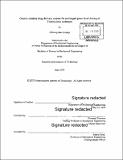| dc.contributor.advisor | Giovanni Traverso. | en_US |
| dc.contributor.author | Ikeanyi, Chinonyelum. | en_US |
| dc.contributor.other | Massachusetts Institute of Technology. Department of Mechanical Engineering. | en_US |
| dc.date.accessioned | 2019-12-13T19:02:44Z | |
| dc.date.available | 2019-12-13T19:02:44Z | |
| dc.date.copyright | 2019 | en_US |
| dc.date.issued | 2019 | en_US |
| dc.identifier.uri | https://hdl.handle.net/1721.1/123290 | |
| dc.description | Thesis: S.B., Massachusetts Institute of Technology, Department of Mechanical Engineering, 2019 | en_US |
| dc.description | Cataloged from PDF version of thesis. | en_US |
| dc.description | Includes bibliographical references (pages 31-32). | en_US |
| dc.description.abstract | Medication non-adherence is one of the biggest challenges facing effective treatment of disease around the world. In developing and developed countries, approximately 50-70% of patients fail to correctly follow the drug regimen prescribed by their health care providers. Gastric resident systems have the potential to improve medication non-adherence as they enable more infrequent dosing, a key recognized determinant of improved adherence. A number of diseases could benefit from a change in treatment protocol in particular those requiring prolonged treatment courses with high pill burdens and where non-adherence could manifest in significant morbidity and mortality to the individual and the public as is the case for communicable disease. Tuberculosis is a disease that requires up to approximately 100 grams of medication to be taken each month for effective treatment. Previous gastric resident devices are limited in their drug loading capacity with most holding less than 500mg at a time. Recently, a multigram gastric resident drug delivery system applied towards the treatment of tuberculosis was reported. This system had to overcome several challenges and several remain. In this thesis, specific contributions made over the last two years to address the device's limitations as well as future improvements will be documented and their significance explained. Namely, working to achieve pulsatile release as well as sustained release through the use of water dissolvable polymer films, increasing the drug load capacity of the device (going from uncompressed powder to pills), and the creation of a high-throughput hole punch device that increased the efficiency of the manufacturing process. These improvements helped to facilitate the creation of gastric-resident device that will be used to affect the lives of patients around the world. | en_US |
| dc.description.statementofresponsibility | by Chinonyelum Ikeanyi. | en_US |
| dc.format.extent | 32 pages | en_US |
| dc.language.iso | eng | en_US |
| dc.publisher | Massachusetts Institute of Technology | en_US |
| dc.rights | MIT theses are protected by copyright. They may be viewed, downloaded, or printed from this source but further reproduction or distribution in any format is prohibited without written permission. | en_US |
| dc.rights.uri | http://dspace.mit.edu/handle/1721.1/7582 | en_US |
| dc.subject | Mechanical Engineering. | en_US |
| dc.title | Gastric-resident drug delivery system for prolonged gram-level dosing of Tuberculosis treatment | en_US |
| dc.type | Thesis | en_US |
| dc.description.degree | S.B. | en_US |
| dc.contributor.department | Massachusetts Institute of Technology. Department of Mechanical Engineering | en_US |
| dc.identifier.oclc | 1130588127 | en_US |
| dc.description.collection | S.B. Massachusetts Institute of Technology, Department of Mechanical Engineering | en_US |
| dspace.imported | 2019-12-13T19:02:43Z | en_US |
| mit.thesis.degree | Bachelor | en_US |
| mit.thesis.department | MechE | en_US |
